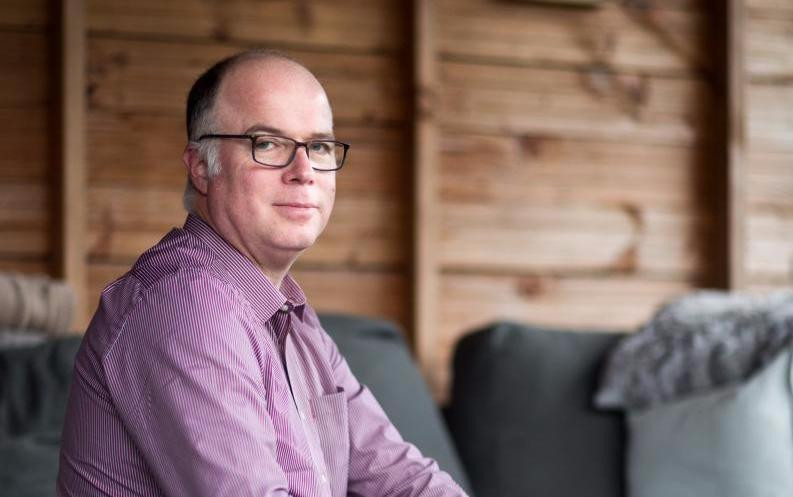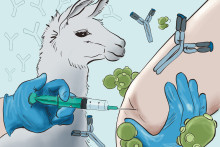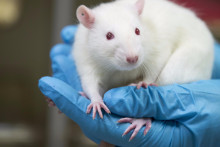Osteoarthritis is one of the major medical problems of our time. In our country alone, about 1.2 million people suffer from osteoarthritis of the joints. Worldwide, there are more than 100 million patients. 'And the actual number is probably higher,' says Marcel Karperien, Developmental Bio-Engineering professor at the UT institute MIRA and a founder of the spin-off Hy2Care. If you consider that almost a third of all osteoarthritis patients suffer from (painful) knee problems, it becomes clear that an injectable plaster, which repairs the damaged cartilage in the knee without surgery or placing a prosthesis, will be a gift from heaven for many people.
Such a plaster is now available. And it does not come from heaven. It has been developed by MIRA, the research centre for Biomedical Technology and Technical Medicine at the University of Twente. The product, which consists of a hydrogel, is almost ready for human use. Since last year, it has extensively been tested on horses, because the intervention by means of keyhole surgery on these animals hardly differs from the intervention on humans. Furthermore, the gel will also be used in veterinary medicine for the treatment of osteoarthritis in pets.Karperien says that the results from these animal studies are so promising that testing on humans may start as early as the second half of 2018.
'If these tests are equally successful, the product may be brought to the market in 2020,' predicts Karperien.
Looking for remedies for osteoarthritis
For the professor, who graduated in Biology at Utrecht University in 1991, this would be a triumph after many years spent looking for remedies for osteoarthritis. He started this research programme in the early nineties at the Hubrecht Laboratory in Utrecht, and continued it between 1995 and 2007 at the Leiden University Medical Centre. 'When I started in Twente in 2007, it was my ambition to combine my knowledge of the skeleton with technological knowledge. I have always been convinced that, based on molecular biology and medical technology, we could create bio-materials that could be used to repair physical defects.'
Karperien's confidence proved justified. Together with his research team, which currently consists of Sanne Both, Piet Dijkstra, Lisanne Karbaat and Bram Zoetebier, he managed to develop the hydrogel, which can be applied as an internal plaster to damaged cartilage and cure the joint. 'The hydrogel consists of naturally produced polymers,' says the UT professor. 'We have chemically modified these sugars, creating a kind of two-component glue. The orthopaedic surgeon injects this glue into the knee joint using a special arthroscopic syringe. The two components then are mixed and fill the gap in the cartilage, providing mechanical stability. This prevents further wear of the joint. Additionally, the gel also facilitates the development of new cartilage cells, which are extracted from the surrounding area. Thus, all gel is ultimately replaced by new cartilage.'

No need to use stem cells
Although solutions for osteoarthritis are also being looked for in other parts of the world, the MIRA research institute is the first to develop a gel which does not rely on stem cells to restore cartilage. According to the professor, this means that treatment with the hydrogel is far less complicated - and therefore much cheaper - than treatment with products containing added stem cells.
It is, therefore, not surprising that there is worldwide interest in the research at the University of Twente. Particularly the world of orthopaedics closely follows local developments and the MIRA invention has frequently caused a stir at international medical congresses. Karperien thinks this is understandable: 'If the hydrogel can be used for the treatment of cartilage trauma, we have the first effective, cell-free treatment with minimally invasive surgery. In other words, there is a real cure for osteoarthritis.'
Subsidies
In the course of the years, the MIRA research into the hydrogel plaster was made possible by various subsidies provided by the EU, the national government, and the Provinces of Overijssel and Gelderland. The research programme currently receives financial support from the National Rheumatoid Arthritis Fund (Reumafonds), the European Regional Development Fund (ERDF), the Proof of Concept Fund, and the STW Perspective programme.
Until recently, this had been lacking. 'If osteoarthritis occurs in a knee due to missing pieces of cartilage, for example as a result of a sports accident, the orthopaedic surgeon can do one of two things. They can remove the loose pieces of cartilage and/or level the edges to create an even surface. By means of microfracturing: drilling small holes in the bone, they can allow bone marrow to enter the damaged cartilage. The second option is replacement of the knee by a prosthesis. The surgeon will postpone the latter solution as long as possible, because of the limited lifespan of the prosthesis, and because a second operation would carry the risk of disability. These are currently the only two options,' says Karperien.
Wound healing in dermatology
However, this situation is about to change. As stated above, professor Karperien expects the hydrogel to be available on the market around 2020. But his quest for cures for osteoarthritis does not end there. 'We are already thinking about the application of hydrogel plasters in other joints, such as the hips. This is another area where there is high demand for a solution. 30% of all osteoarthritis patients suffer from knee osteoarthritis and 20% suffer from hip osteoarthritis. In our country alone, there are about 600,000 patients.' In addition, Karperien believes the gel plaster can be used in wound healing in dermatology and even in combination with insulin-producing cells in the islets of Langerhans.
'In short,' says the professor, 'there is enough work to keep us busy for many years.' He characterises his job as 'wonderful' and 'of obvious relevance'. Karperien says that being able to cure patients with the help of technology is the greatest thing there is. 'That is also my biggest inspiration to continue all this research.'







